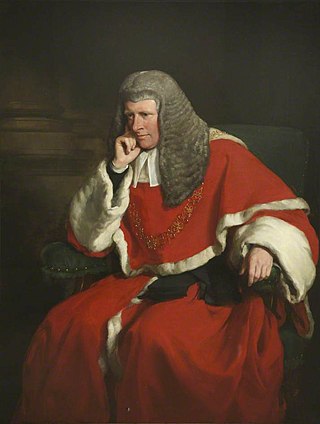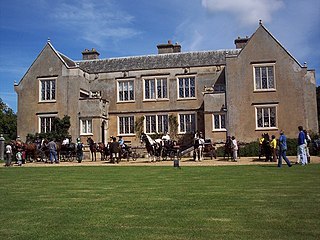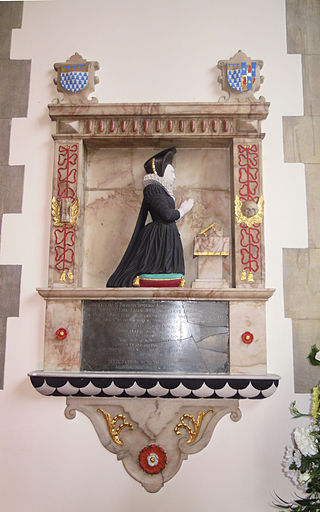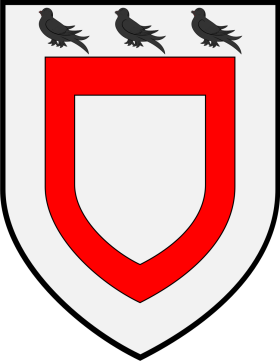Related Research Articles

In a legend, Saint George—a soldier venerated in Christianity—defeats a dragon at Dragon Hill, Uffington. The story goes that the dragon originally extorted tribute from villagers. When they ran out of livestock and trinkets for the dragon, they started giving up a human tribute once a year. This was acceptable to the villagers until a princess was chosen as the next offering. The saint thereupon rescues the princess and kills the dragon. The narrative was first set in Cappadocia in the earliest sources of the 11th and 12th centuries, but transferred to Libya in the 13th-century Golden Legend.

The New Forest is one of the largest remaining tracts of unenclosed pasture land, heathland and forest in Southern England, covering southwest Hampshire and southeast Wiltshire. It was proclaimed a royal forest by William the Conqueror, featuring in the Domesday Book.

Marchwood is a village and civil parish located in Hampshire, England. It lies between Totton and Hythe on the western shore of Southampton Water and directly east of the New Forest. The population of the village in the 2011 census was 6,141.

William Paulet, 1st Marquess of Winchester, styled Lord St John between 1539 and 1550 and Earl of Wiltshire between 1550 and 1551, was an English Lord High Treasurer, Lord Keeper of the Great Seal, and statesman.

Princess and dragon is an archetypical premise common to many legends, fairy tales, and chivalric romances. Northrop Frye identified it as a central form of the quest romance.

Lyndhurst is a large village and civil parish situated in the New Forest National Park in Hampshire, England, about nine miles (14 km) south-west of Southampton. Known as the "Capital of the New Forest", Lyndhurst houses the New Forest District Council and Court of Verderers. It is also a popular tourist attraction, with many independent shops, art galleries, cafés, museums, pubs and hotels. As of 2001 Lyndhurst had a population of 2,973, increasing to 3,029 at the 2011 Census.

The White Company is a historical adventure by British writer Arthur Conan Doyle, set during the Hundred Years' War. The story is set in England, France and Spain, in the years 1366 and 1367, against the background of the campaign of Edward the Black Prince, to restore Peter of Castile to the throne of the Kingdom of Castile. The climax of the book occurs before the Battle of Nájera. Doyle became inspired to write the novel after attending a lecture on the Middle Ages in 1889. After extensive research, The White Company was published in serialised form in 1891 in The Cornhill Magazine. Additionally, the book is considered a companion to Doyle's 1905–06 Sir Nigel, which explores the early campaigns of Sir Nigel Loring and Samkin Aylward.

Sir Ywain, also known as Yvain and Owain among other spellings, is a Knight of the Round Table in Arthurian legend, wherein he is often the son of King Urien of Gorre and either the enchantress Modron or the sorceress Morgan le Fay. The historical Owain mab Urien, on whom the literary character is based, was the king of Rheged in Great Britain during the late 6th century.

Sir William Erle PC FRS was an English lawyer, judge and Whig politician.

Jane and the Dragon is a CGI children's animated television series based on the books of the same name by Martin Baynton. The show is directed by Mike Fallows and the motion capture is directed by Peter Salmon; it is co-produced by Weta Workshop in New Zealand and Nelvana Limited in Canada. The series follows the comedic exploits of Jane-- an adolescent girl training to be a knight-- and her friend Dragon-- a talking, flying, 300-year-old, fire-breathing dragon. The program originally aired on YTV in Canada and on ABC in Australia. It also aired on the Qubo weekend lineup from September 9, 2006 until 2021, when the network shut down1. It can be seen on Five in the UK. In American broadcasts, it bears the E/I bug. Episodes are available as part of the "Kids Suite" sold via Bell/Rogers in Canada and are broadcast on Tuesdays on Disney Junior on the Disney Channel. It has also been on Treehouse TV.

Minstead is a small village and civil parish in the New Forest, Hampshire, about 2 miles (3.2 km) north of Lyndhurst. There is a shop and a pub, the Trusty Servant. Sir Arthur Conan Doyle's grave is under a large tree at the back of the 13th century All Saints' church.

Burley is a village and civil parish in the New Forest, Hampshire, England. It has ancient origins and is now somewhat tourist-orientated.
Sir Hugh Wyndham SL, of Silton, near Gillingham, Dorset, was an English Judge of the Common Pleas and a Baron of the Exchequer.
Sir Henry le Scrope was an English lawyer, and Chief Justice of the King's Bench for two periods between 1317 and 1330. He was the eldest son of Sir William le Scrope, who was bailiff to the earl of Richmond in Richmondshire. Henry's younger brother Geoffrey was also a lawyer who probably advanced through the influence of his older brother. Geoffrey served as Chief Justice four times between 1324 and 1338.
Gerard II de Lisle, 1st Baron Lisle of Kingston Lisle was an English nobleman and soldier during King Edward III's campaigns in Scotland and France.

Bisterne is a hamlet in the civil parish of Ringwood in the New Forest National Park in Hampshire, England. Its nearest town is Ringwood, which lies 3 miles (4.8 km) to the north.

Sir Richard Tichborne, 2nd Baronet was an English politician who sat in the House of Commons from 1597. He was a Royalist commander in the English Civil War.

Sir Maurice Berkeley of Bruton in Somerset and of Berkeley House, Clerkenwell, Middlesex, served as Chief Banner Bearer of England to Kings Henry VIII and Edward VI and to Queen Elizabeth I, and rose rapidly in the Tudor court. He came from a cadet branch of the great Berkeley family of Berkeley Castle in Gloucestershire, but in his career, his initial advantage was due to his mother's second marriage to Sir John FitzJames, Lord Chief Justice of the King's Bench 1526–1539, which by 1538 had brought him into the household of Thomas Cromwell, from which he passed into the royal household by 1539.

Clan Rutherford or Rutherfurd/Rutherfurd is a Lowland Scottish clan of the Scottish Borders. The clan is officially recognized by the Lord Lyon King of Arms, however as it does not currently have a clan chief that is recognized by the Lord Lyon King of Arms it is therefore considered to be an armigerous clan.

Sir Piers Shonks was a legendary figure in the village of Brent Pelham in Hertfordshire, England, whose tomb is within the north wall of the village's church. According to local legend, Shonks slew a dragon that was causing havoc in the district and later cheated the Devil from claiming his soul by being buried within the walls of the church.
References
- 1 2 3 John Henry Blunt, (1877), Dursley and its neighbourhood; being historical memorials of Dursley, pages 124-6
- ↑ New Forest Hauntings, Historic-UK, 2016
- ↑ National Archives; Plea Rolls of the Court of Common Pleas; year 1433; CP40/689; image seen at: http://aalt.law.uh.edu/AALT1/H6/CP40no689/aCP40no689fronts/IMG_0606.htm seen in the first entry, in Latin, as the plaintiff: Mauricus Berkeley nuper de Bystern, in Com' Sutht
- ↑ Victoria County History, (1911), A History of the County of Hampshire: Volume 4, pages 606-614, Ringwood
- 1 2 Elizabeth Hodges, (1895), Some ancient English homes and their associations; personal, archæological & historic, pages 55-6
- ↑ Edward Rutherfurd, (2001), The Forest, pages 264-9